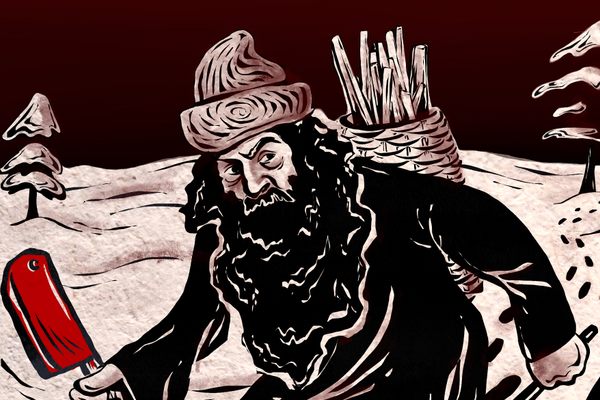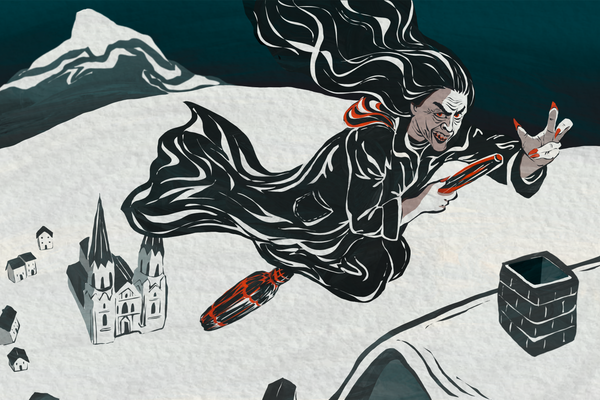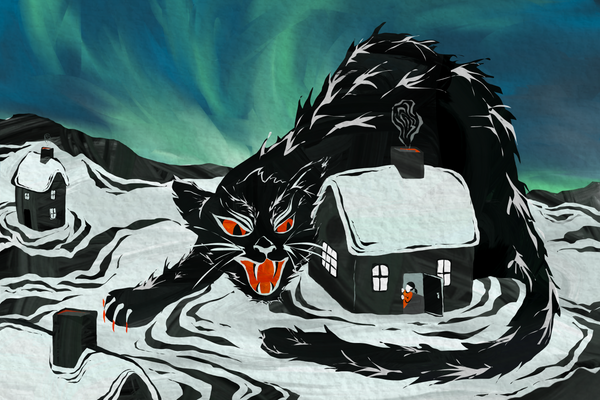The Monsters of Christmas
Many of the ancient pagan observances during midwinter have been transformed or forgotten by our modern society. If you look into the origins of traditions practiced around Christmas today, you might be surprised to discover that the Christmas pastimes you know so well are themselves teeming with the macabre and strange.
However, in some countries where people have held fast to these ancient traditions, Christmas brings with it unthinkable terrors. For some, Christmas is a season filled with supernatural goings-on, ghosts, witches, magic, and especially monsters.
KRAMPUS
all illustrations by Dylan Thuras
Santa’s European counterpart and earliest incarnation — Saint Nicholas — brings something other than just presents to your house. He brings along a demonic sidekick, Krampus. While the good children get gifts from Saint Nicholas, Krampus is given leave to mercilessly beat the naughty ones, shove them into his sack, and carry them promptly to Hell.
MARI LWYD - THE CHRISTMAS ZOMBIE HORSE
This macabre skeleton mare of Welsh tradition rises from the dead and wanders the streets with her attendants, who are also fresh from the grave, to remind the living of their existence. Mary Lwyd has only one goal in mind — to get into your house. To keep the zombie horse out, you must engage in a battle of wits… in rhyme no less, usually on New Year’s Eve, where the undead mare is represented by a puppeteer parading a horse skull on a pole draped in white cloth.
LA BEFANA AND BABOUSHKA
In Italy, Russia, and parts of Eastern Europe, we encounter a witch-like lady rooted in the fairy tale figure of Mother Holle who doles out punishments for the lazy, and riches for the hard working. In Italy she is known as La Befana and in Russia, Baboushka. Each January, she packs up and sets off on a broomstick to join the three kings who are also seeking the Christ Child. She searches every house and if she finds a child there, she leaves cookies and gifts behind.
PERCHTA
On New Year’s Eve, Perchta roams the earth rewarding those who are hard working and generous, and punishing the idle and greedy. Her punishment of choice involves slashing open your stomach so she may violently rip out your intestines, which are then replaced by straw, rocks, and garbage. The tradition of having goose for Christmas is sometimes linked to witches like Perchta, who is often depicted as having a goose foot, along with the belief that goose fat enabled witches to fly.
STRAGGELE
In many places, such as Switzerland, Perchta rides with a throng of demonic-looking helpers — known as Straggele — who love to partake of the feast offerings left out for them on Christmas by people hoping for Perchta’s blessings of wealth and health in the new year. In some places, Straggele get to dole out the punishments themselves and aren’t terribly discerning as they rob all bad children and tear them to pieces in the air.
THE TOMTEN
A creature from Scandinavian folklore who bears a resemblance to a gnome and lives among the dead inside burial mounds, the Tomten acts as a caretaker, protector, and helper of the household, that is if you don’t anger him. The Tomten has quite the temper and is known for driving people insane with his tricks or biting them. The bites — being poisonous — typically lead to death. You would be well advised to leave a gift of food out on Christmas Eve for this fellow.
BELSNICKEL
In some German and Pennsylvannia Dutch communities, Belsnickel shows up a couple weeks before Christmas, filthy and dressed in rags and furs to beat the children who have misbehaved. As an 1872 Philadelphia newspaper recounted: ”Mr. Belsnickel [makes] his personal appearance dressed in skins or old clothes, his face black, a bell, a whip, and a pocket full of cakes or nuts; and either the cakes or the whip are bestowed upon those around…” Back in the 19th century it was popular for rowdy revelers to go “Belsnicking” and get drunk, vandalize the city, and play pranks.
PERE FOUETTARD
Père Fouettard made his first appearance in 1150, when he and his wife lured a trio of young boys into their butcher shop so they could rob them. Fouettard slit their throats and butchered the children, placing their remains in a barrel. When Saint Nicholas discovered the crime, he resurrected the boys and punished Fouettard by forcing the butcher into his eternal service. Now, this villain appears alongside Saint Nicholas and dispenses coal and floggings to those who deserve them.
GRYLA
One of Iceland’s most renowned figures associated with Christmas — Gryla — is a giant troll who is in a perpetual bad mood due to her insatiable hunger… for children. Each Christmas, Gryla comes down from her mountain dwelling to hunt for naughty children. She places them in a sack and drags them back to her cave where she boils them alive for her favorite stew. Oh, and she has thirteen sons —the Yule Lads.
THE YULE LADS
The thirteen sons of Gryla, the Yule Lads are each known for a particular habit or characteristic, much like the Disney version of Snow White’s seven dwarves. Most of them are depicted as mischievous pranksters and petty criminals. Icelandic children are visited each night on the thirteen days leading up to Christmas by a different Yule Lad, including such charmers as:
“Sheep Cote Clog,” a peg-legged sheep fancier; “Gully Hawk” who hides out in ditches or gullies and waits for an opportune moment to run into the cow shed and lick the foam off the milk in the milking buckets; “Stubby” whose name denotes his stature as he is unusually short; “Spoon Licker,” a licker and thief of spoons; “Pot Scraper” who is a petty thief of leftovers; “Bowl Licker” who hides under your bed and waits for you to absentmindedly put down your bowl so he can steal and yes, lick it; “Door Slammer” who slams doors all night; “Skyr Gobbler” who eats “skyr” yogurt; “Sausage Swiper” who steals sausage; “Window Peeper” who watches you from the windows; “Doorway Sniffer” who uses his incredibly large nose to sniff through doors to find bread; “Meat Hook” who always brings a hook along with him so he can steal meat; and “Candle Stealer” who follows children around so he can steal their candles, leaving them in the dark.
THE YULE CAT
The pet of both Gryla and The Yule Lads, the Yule Cat’s prey consists of both children and adults. Unlike the other Christmas monsters, this cat does not care about your misdeeds during the year. The only insurance against being torn apart and eaten by this giant feline is receiving an article of new clothing for Christmas. Shop wisely.
Illustrations by Dylan Thuras.
Find more about the horrors of Christmas on Sarah Elizabeth Troop’s blog: A Scary Little Christmas.









Follow us on Twitter to get the latest on the world's hidden wonders.
Like us on Facebook to get the latest on the world's hidden wonders.
Follow us on Twitter Like us on Facebook